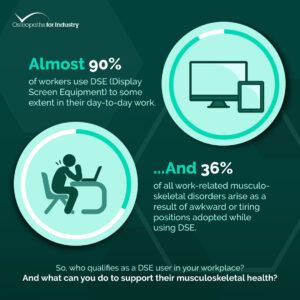It probably won’t surprise you to hear that in the modern world, almost 90% of workers use Display Screen Equipment (DSE) to some extent in their day-to-day work.
Not all of these people, however, qualify as DSE users. So, what makes someone a ‘DSE user’? Before you can implement the proper risk prevention methods necessary to protect your team from the physical impacts of spending prolonged periods working with DSE every day, you need to be able to identify who is a DSE user, and thus who is at most risk of these issues.
The Health and Safety (Display Screen Equipment) Regulations lay down comprehensive guidelines on this subject, and in this blog post, we’ll be helping you get to grips with what makes someone a DSE user and the regulations that govern their use of DSE, as well as some examples of DSE users in the workplace.
Unpacking the Definitions: Display Screen Users and Operators
According to DSE regulations, those who qualify as DSE users consist of workers who routinely use DSE as a significant part of their work. This umbrella includes users stationed in the workplace, those working from home, and even individuals operating at another user’s workstation. Importantly, these regulations also extend their protective reach to self-employed professionals working at an employer’s workstation (as long as their DSE usage aligns with that of an employed user).
DSE & The Wellbeing Issues It Could Cause You and Your Team
Excessive use of Display Screen Equipment (DSE) can adversely affect anyone’s health and well-being. While DSE, such as computers and other electronic devices, has become an integral part of modern work, prolonged and improper usage can lead to several health issues. If you’re a DSE user or have been in the past, the chances are you might recognise some of these common issues…
- Musculoskeletal problems, such as repetitive strain injuries or back/neck pain, due to poor posture or excessive use of a keyboard
- Visual fatigue, including eye strain and blurriness, due to prolonged screen exposure
- Mental health issues, such as stress or burnout
- Disruption of regular sleep patterns
- Sedentary behaviour, which can lead to other health risks, including obesity
- Radiation exposure due to exposure to electronic devices over long periods
Before you can take action in order to mitigate these kinds of risks for your team, the first step is to identify which of your employees are regular DSE users who might require risk prevention measures to keep them feeling happy and well.
OFI provides detailed Display Screen Equipment risk assessments and assessor training, either online or in person. To learn more about how we can help you ensure the well-being of your employees, browse our DSE services here.
Identifying Display Screen Users
Identifying whether a member of your team can be considered a DSE user hinges on the nature and extent of their DSE use. Factors such as the frequency, duration, intensity, and pace of continuous DSE use all play a pivotal role in influencing the associated risk factors they may be in danger of experiencing.
Criteria for Display Screen User Classification
So, who qualifies? Check the following criteria to identify DSE users in your workforce:
- Continuous or Near-Continuous Use: Individuals who regularly engage in DSE use for an hour or more on a daily basis.
- Daily Usage: Daily reliance on DSE, particularly in tasks which involve quick information transfer and demand high attention and concentration.
- Specific Skills or Training: Jobs which require special training or skills for the safe operation of DSE.
- Dependence on DSE: Roles where individuals are highly dependent on DSE or have limited choices regarding its usage
Some Examples of Display Screen Users
Who classifies? Here are some examples…
Definite Display Screen Users
- Word Processing Worker: Involved in full-time document creation and amendment, incorporating a mix of on-screen document checks, keyboard inputs, and formatting, with breaks in between.
- Secretary or Typist: Uses DSE regularly (several hours a day) for typing reports, letters, and emails.
- Data Input Operator: Engaged full-time in the continuous processing of invoices, involving predominantly numeric input, and possibly subject to keystroke monitoring.
- Television Editing Technician: Primarily involved in using DSE to view and process video sequences for broadcasting.
- Graphic Designer: Working on multimedia applications with intensive scrutiny of images at high resolution using multiple input devices.
Possible Display Screen Users
- Scientist/Technical Adviser: Engaged in word processing and periodic, intensive DSE use for data analysis of research results.
- Client Manager: Daily use of email for communication, with the duration determining the classification as a user.
- Community Care Worker: Utilises a laptop for note-taking during and after field interviews or visits.
- Building Customer Support Worker: Works in an office with a display screen workstation. DSE is used during client interviews, for transactions, or to prepare financial documents/estimates.
Definitely Not Display Screen Users
- Senior Manager (Infrequent Use): Occasionally monitors markets or uses DSE briefly to generate and manipulate statistics.
- Receptionist (Customer Interaction): Primarily involved in customer-public interaction with occasional DSE use for limited purposes.

Did You Know?
36% of all musculoskeletal disorders in the workplace come as a result of awkward or tiring positions while using DSE. We often think of workplace injuries as being caused by big events, like manual handling accidents, for example. However, injuries and poor mental/physical wellbeing can just as likely be caused by the accumulative attrition of something as commonplace as poor posture.
In Summary
It’s essential to understand who qualifies as a DSE user in order to identify who you need to protect from the associated physical/mental health implications. When doing this, it’s important to evaluate each employee’s tasks and level of DSE usage so you can tailor your approach to DSE safety and limit the associated risks with care and effectiveness.
Are you a DSE user? Don’t forget to take the same measures to protect yourself.
Next Steps:
Now you’ve identified who qualifies as a DSE user, watch out for future blog posts to read up on what measures you can take to ensure their safety.











